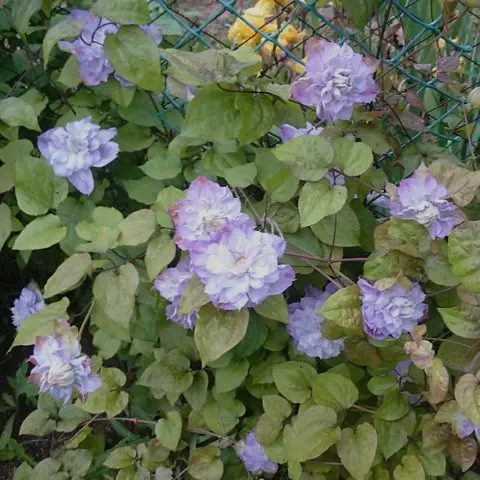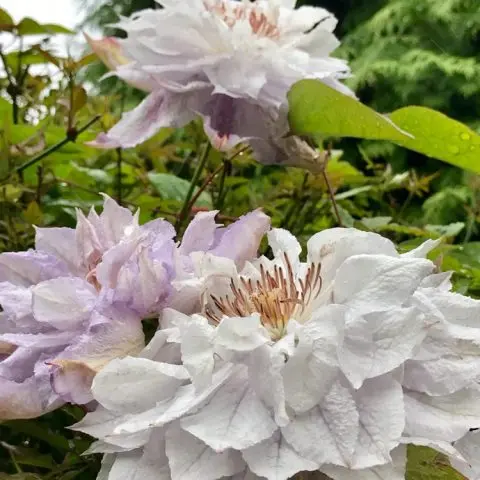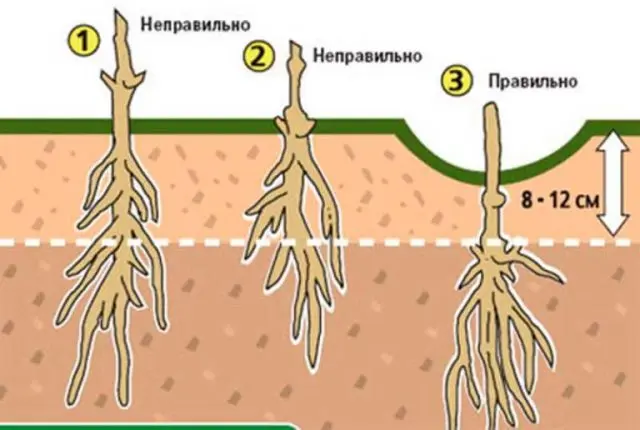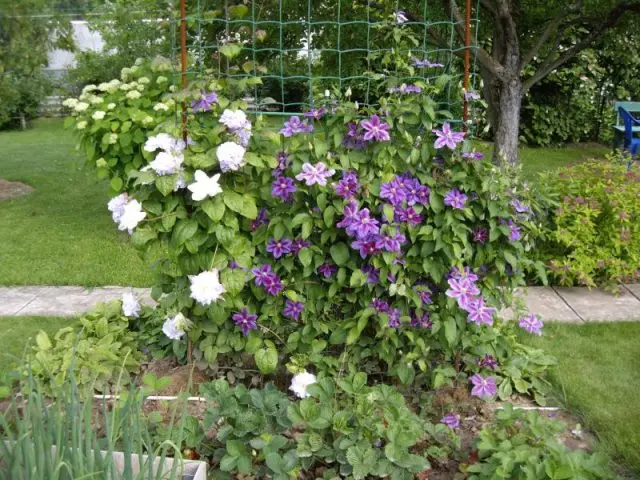Contents
Clematis Veronica Choice, bred in England, has been distributed in gardens since 1973. The plant is not very winter-hardy, in the middle lane it requires careful shelter. Worries are compensated by magnificent early and autumn flowering.

Description of clematis Veronica Choice
Liana is medium tall, rises to 2,5-3 m with the help of leaf petioles, with antennae which clings tightly to the support. The root system of clematis variety Veronika is powerful, fibrous, deepens to 35-40 cm, consists of a dense bundle of processes that emanate from the base. Width of reddish-brown stems from 2 mm. The leaves are large, ovate, with a pointed tip.
Luxurious Veronica Choice flowers open in June. The first flowering lasts 35-40 days. The bush blooms again in August. The clematis buds that open from the beginning of summer are terry, very lush, with large lower sepals. Petals in the center are white with a lavender sheen, smaller in size, with a pointed tip. Towards the edges, the lilac color becomes more intense, sometimes turning to purple at the border. The edges of the petals are wavy. The central “spider” is yellow or creamy yellow.

The first flowering with terry buds takes place on overwintered vines. For the second time, the Veronica Choice bush blooms on the stems of the current year. A young clematis vine creates simple buds with 6 large sepal petals. In favorable conditions, additional formation of several small petals is possible. The size of the opened corolla in the first and second waves of flowering is 15-16 cm.

Clematis pruning group Veronica Choice
Early clematis with large voluminous flowers belongs to the second pruning group. After the corollas of the first wave wither, the vines that remained from the previous year are cut off. Young stems develop intensively and create buds. In autumn, they are cut from above, leaving 90-100 cm above the ground.
Planting and caring for clematis Veronica Choice
According to the photo and description, Clematis Veronica Choice creates an expressive picturesque effect in the landscape, and care for the care of the large-flowered liana is justified by the result. In regions with a mild climate, clematis is planted in the fall. Shrubs in containers are transplanted throughout the warm season. When landing, follow the recommendations:
- exposition southeast, south, southwest;
- a sunny place, protected from wind and drafts;
- a plot without high groundwater, without stagnant moisture;
- the soil is slightly acidic or neutral;
- the interval between seedlings is at least 70 cm;
- superphosphate and humus are placed in the pit, clay is added on sandy loam, sand is added on loam;
- in areas with heavy soils, drainage must be arranged.

A hole with a seedling of large-flowered clematis Veronica Choice is left uncovered with soil to the surface level. This makes it easier for the bush to create new shoots. As new stems grow, the hole is supplemented with soil, and in the fall they are compared and mulched.
Watered 1-2 times a week if there is no rain. Under one seedling, up to 10 liters of water are consumed. If clematis is placed in the sun, the trunk circle is mulched or undersized ground covers are planted. Plants develop better and bloom luxuriantly in the sun, but clematis roots must be protected from overheating and overdrying of the soil. In the south, Clematis Veronica’s Choice is placed in an area where a slight shade forms at noon.
The variety is fed with complex fertilizers, and in the spring with organic matter. Half of the humus can also be included in the autumn mulch.
Preparation for winter
At the end of September or later, depending on the region, after trimming the vines, the near-trunk circle is filled with soil, compared with the ground in the garden. Lay a high layer of mulch. Clematis variety Veronica Choice is relatively winter-hardy, tolerates short-term frosts down to -29 ° C, and long-term frosts only up to – 23 ° C. In November, the stems are twisted and placed under shelter from spruce branches, burlap, and reeds.
Reproduction
The variety of large-flowered liana Veronica’s Choice is propagated only by vegetative methods:
- cuttings;
- layering;
- dividing bushes.
For cuttings in June, the middle part of the vine is cut off, divided into fragments so that there are 2 vegetative buds each. Rooted in the substrate of a mixture of peat and sand for 40-60 days. Wanting to get sprouts from layering, they add a strong healthy vine in the spring, bringing the top to the surface. Shoots grow from the nodes. They are transplanted after a year. Clematis bushes are divided in autumn or early spring, after the snow melts.
Diseases and pests
According to reviews, Clematis grandiflora Veronica Choice is quite resistant to diseases. But under adverse conditions, it becomes infected with various pathogens of fungal infections:
- in the area where the acidity of the soil is below pH 5;
- sewage accumulates at the planting site of clematis;
- creeper grows in the shade.
Especially in such situations, the roots are prone to diseases. Then the stems and leaves become covered with yellowish and brown spots, wither and dry. For prevention, plants are systematically treated: they are watered under the roots with a solution of foundationazole, according to the instructions. The drug is also used in case of illness. Too affected clematis, with rotten roots, are removed from the site, and the growth site is also treated with foundationazole.
In summer, clematis can suffer from powdery mildew, gray mold, rust and other infections. Protect clematis in autumn and early spring prophylactically, spraying with copper sulphate, Bordeaux liquid, and fungicides are used for diseases.
Against leaf-eating insects, vines are sprayed with insecticides. If the clematis has withered and needs to be removed, the roots are carefully examined to see if they have galls formed by the nematode. If there are swellings in the hole, clematis should not be planted for several years.

Conclusion
Clematis Veronica Choice with large flowers in delicate pastel colors will create an exquisite decor in a bright, sunny and cozy place. The variety is often grown as a container crop. Compliance with the requirements of agricultural technology and annual prevention will protect the picturesque plant from diseases and pests.









